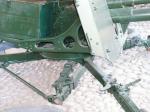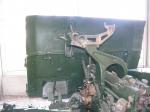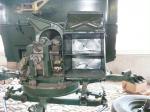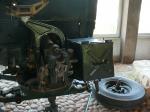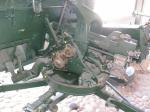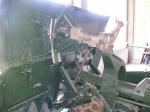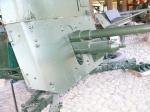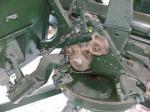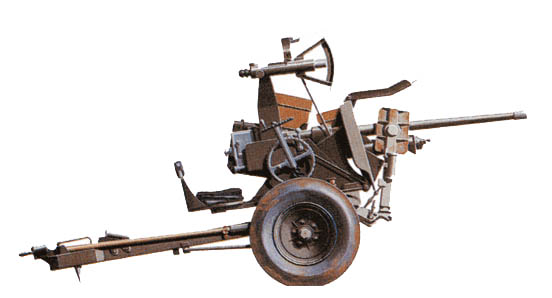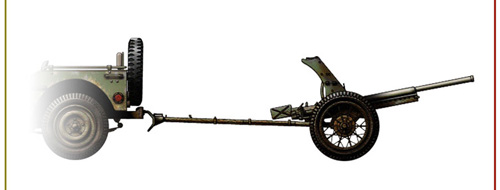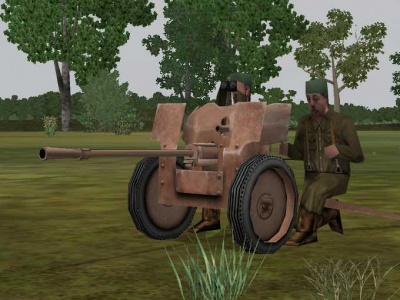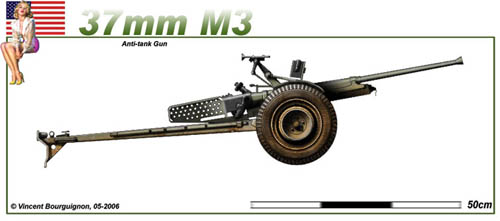l
2 Pdr AT Canon (AC ORDNANCE QF2 livres )
English Translation
Introduction Ce canon anti-char connu sous le vocable ORDNANCE QF 2 livres a mauvaise réputation. Pourquoi ?
Très prometteur lors de sa mise au point, il entra en fabrication, trop longtemps après et il était déjà obsolète lors de sa livraison aux unités. Pourtant il avait tout pour être un excellent canon.,avec un affût révolutionnaire qui permettait de faire pivoter l 'arme sur 360,une excellente Vitesse de pénétration (V° )
Historique Concu pour remplacer en 1934 le canon 3 pdr devenu obsolète , il fut décidé de monter ce canon sur un affut anti char afin de donner à l’Armée Britannique un canon léger anti tank mais aussi puissant Ce choix aussi entraina le montage de ce canon sur divers engins blindés facilitant par la même une standardisation du matériel et aussi de la production . En décembre 1935 fut placé la première commande de materiel . Toutefois ce n’est qu’en Avril 1937 que l’Arsenal de Woolwich délivra le premier matériel
Mais revenons un peut en arrière:En Janvier 1935, le programme de ce nouveau canon fut approuvé . Il devait avoir un affut bas avoir des capacités tout terrain et pouvoir être tracté à la vitesse de 40 km/h. La maquette de ce canon fut prête en mai Juin 1935 Les essais vont commencer apres que les engins de pré séries commandés auprès de Vickers et Woolwich aient été fabriqués.
Entre Novembre 1935 et juin 1936 les effets vont bon train ,suivis rapidement de la commande de ce canon (Vickers design (Mk I) ).44 engins sont commandés dans l’urgence suite à ,l’aggravation de la situation internationale . Une premiere modification de l’affut par Woolwich( design Mk II) intervient rapidement . Cette modification rend la manipulation de l ‘engin plus aisé . Durant sa carrière dans l’armée ce canon va voir plusieurs versions . Ces modification porterons sur le canon et l’affût surtout dans un but de simplifier la production industrielle
Ainsi à l’Automne 1939 apparaît l’affût Mark IV plus léger (pouvant être équipé d’un 2 ou 6 pounder )mais avec une diminution de la possibilité de tirer en site et en azimut
Mais cet affût ne fut monté que sur le 6 pdr juste avant la campagne de France (Mk IV) .L’arrivée aussi du nouveau canon de 6 pounder changea la donne car il fut préféré au 2 pounder
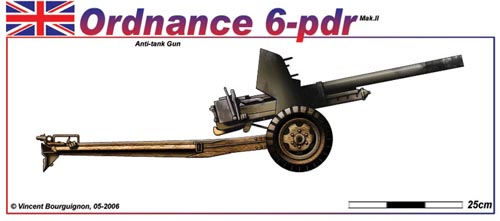 |
Comme autre innovation en plus de son affût "révolutionnaire " il avait sur le coté une réserve d'obus dans un coffre à munitions.
Le 2 Pdr au Combat Ce canon fut utilise au debut de la 2 GM par l’ Armée britannique s dans les Regiments anti chars des DI ( 4 batteries de 12 pieces ) et dans les regiments légers anti chars et anti aériens des DB (2 batteries de 12 canons ) . en octobre 1940 nous voyons la création d’un régiment anti char autonome de 48 pièces dans les divisions blindées En 1942 les Bataillons d’infanteries recoivent un peloton de 6 canons anti char L’organisation en Extrème Orient est différente
Après la guerre d’Espagne le canon connaît l’épreuve du feu en France avec l’armée Belge et Britannique Les pièces capturées par les Allemands furent réutilisées par eux sous le vocable 4.0 cm Pak 192 (e) or 4.0 cm Pak 154 (b)
.Il combat ensuite en Afrique du Nord ou parfois il sert comme pièce d artillerie . A la mi 1942 il est affecté à la Home Guard et il est envoyé aussi En Extrème Orient combattre les Chars Japonais
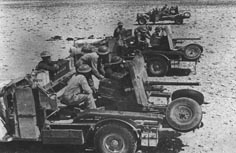 |
| 2Pdr porté (source internet ) |
En décembre 1945 il est retiré du service Plus de 7000 canons furent construits
Ce canon n'était pas adapté à la guerre éclair . il fut aussi monté sur les chars Matilda , Crusader et Valentine, Tetrach, Churchill, Sentinelle, Ram, et les automitrailleuses Coventry AEC les Marmon Herington ainsi que les Bren carrier
Il fut aussi utilisé par les troupes japonaises qui en ont capturé et ensuite copié
Munitions
le 2 pdr pouvait à l’origine tirer des obus antichar (obus anti char classique ) mais en Septembre 1934 des études qui vont aboutir en Janvier 1936 vont permettre de fabriquer des obus avec de la Lyddite(c’est en effet un explosif avec une puissance légèrement supérieure à celle du TNT.)
Ce qui fait qu’en 1938 ce canon avait une puissance jusque là inégalée d’autant qu’un nouveau projectile fut étudié pour accroître la puissance de
La production initiale des munitions du 2pdr AP fut confiée à l’usine Hadfields,mais elle a été couverte par un secret absolu . Mais devant la dégradation de la situation internationale et la demande sans cesse acrrue de munitions en1939 et 1940 il devint impossible de confier la construction de cette munition à une seule firme .En effet 6 Millions d’obus commandés pour 1940 et Hadfields ne pouvait en produire que 80000 munitions /mois Aussi d’autres usines furent choisies pour fabriquer cette munition ; La production atteindra en février 1942 la cadence de 1 Million d’obus .
En septembre 1942 fut introduit une nouvelle munition qui lui assurait une meilleure V° et à la fin de 1942 une nouvelle munition avec un noyau de tungstène pouvant perforer de face le blindage des chars allemands fut introduite
Pour des raison de secret ce projectile connu sous le nom de 2pdr Little john Mark I entra production seulement en Janvier 1943 ; Il fut suivi en mai 1944 par le Mark II qui pouvait percer les blindages espacés
Versions
Mk IX production pré- guerre.
Mk IX-A - Mk IX production de masse version Mk IX simplifiée
Mk X production tardive (nouveau canon ).
Mk X-A - Mk X tolérances supérieures admises lors du tir
Mk X-B – fin de guerre adapté pour le projectile Littlejohn .
Ce canon est exposé à Draguignan dans le Musée de l'Artillerie. Je remercie l'équipe du colonel Aubagnac pour leur accueil
CARACTERISTIQUES
Constructeur :Vickers Armstrong
Calibre :40mm Equipe de piece:3
Longeur :3.44 m
Largeur:1.4 m
Hauteur:1.5 m
Poids :838 kgs
Site:+15° / -13° Azimut :360°
Cadence de tir :15 à 20 coups minute
Portée 550 m
Frères d'armes
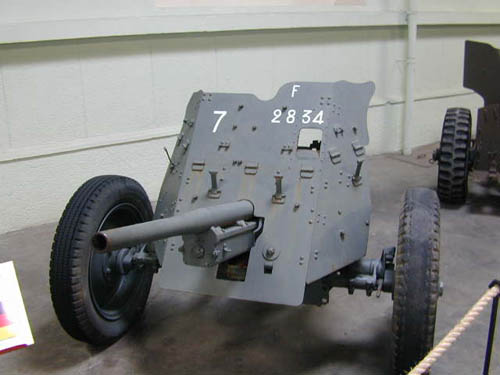 |
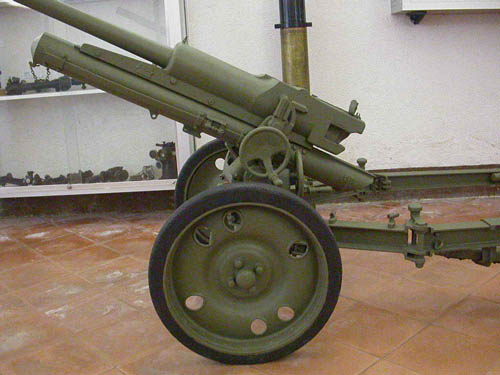 |
| Pak 36 (Allemagne ) |
Bolshen (Italie ) |
Merci à Vincent Bourguignon pour l 'autorisation de publication de ses dessins
Autres Photoscopess (Others Walk around) 1 2 3 4
2 Pounder Anti Tank Gun ( Gun AC ORDNANCE QF2 )
Introduction
This anti-tank gun known under term ORDNANCE QF 2pdr has bad reputation. Why?
Very promising at the time of its development, it entered in manufacture, too a long time afterwards and it was already obsolete at the time of its delivery to the units.
However it had very to be an excellent gun. A revolutionary mounting which made it possible to pivote the gun 360 ° , an excellent Speed of penetration (V°)
History
The 2 pdr was originally designed as a tank gun in 1934 to replace to obsolete 3 pdr gun but it was decided to mount the gun on an anti tank carriage to provide at the British Army a light gun but powerful able to fire shell for anti-tank defence .
This adoption of the same weapon for both tank and anti-tank would be a great advantage from a manufacturing point of view. The first order of guns was placed in December 1935 with Woolwich Arsenal and the first deliveries were made in April 1937
Now a little return in the Past . In January 1935 the 2pdr for tank armament was approved, The design was: a low travelling carriage was requested, and this e carriage was to have all round transverse and be capable of being towed at 25mph.
The Mock-ups was ready in May and June 1935 and orders of trial equipment were placed with Vickers and Woolwich.
Exhaustive trials were staged between November 1935 and June 1936,
In July 1936 the Vickers design (Mk I) was approved and 44 carriages were ordered in emergency measure because of the international situation .
The carriage of Woolwich design (Mk II) was also approved for future manufacture on grounds of ease of manufacture, inspection and handling
Over the years many modifications were made to the gun and carriage, the majority of these were designed to simplify production.
In the autumn of 1939 a new carriage of split-trail type was designed (Mk IV) to accommodate either a 2pdr or a 6pdr gun, this reduced transverse from 360 to 90, but was lighter to handle and easier to produce, this carriage was accepted in early 1940.
 |
But the new 6 pdr AT gun slack the production of the 2 pdr The 2 pdr Mk IV carriage was not produced as it was decided to produce 6pdr carriages instead.
It was manufactured by the firm Vickers Armstrong in 1934. and it knew the baptism of fire in Spain, but it equip only the British Army in 1938 ( version Mark III )
As another innovation after his revolutionary mounting is the shells reserve in a munition box by the gun
The 2 Pdr at war He figth with the British Army in the AT Regiments if Infantry Divisions (4 batteries of 12 guns ) and in the light anti tank and anti aircraft regiments of the of armoured divisions (two 12-gun AT batteries). In October 1940, separate 48-gun anti-tank regiments were introduced in armoured divisions From 1942, infantry battalions received their own six-gun anti-tank platoons. The organization was different for the Far East theater of operation
After the Spanish Civil War the gun saw combat in France with the Belgian an Brtitish Army.The guns captured entered German service under the designation 4.0 cm Pak 192 (e) or 4.0 cm Pak 154 (b)
He fight in North Africa as an anti-tank gun – but also in artillery role.
The evolution of armour or german tank design meant anti-armour performance of the 2-pdr gradually became insufficient he was send in Far east to figth japanase tanks or in Great Britain fot r the Home Guard units
 |
| 2pdr on trucks (source internet ) |
It was finally removed from service entirely in December 1945. Total production :7000+
This gun was not provided for the Lamp War It was also placed on mobile platforms
(trucks)It was also used in the Matilda Valentine and Crusader Tetrach, Churchill, Sentinel, Ram,Tanks and the armoured cars Coventry AEC les Marmon Herington and also les Bren carrier
This gun entered also in Japanese service (Captured or copies )
Munition
The 2 pdr was originally armed with AP Shell (an armour piercing round with an explosive filler), but in September 1934 studies ended in January 1936 bring into focus au new shield filled with Lyddite.(explosive superior to TNT.)
In fact in 1938 the Bristihs Army has in this arsenal a little but a powereful anti tank gun
Initially all production of 2pdr AP shot was by Hadfields, in the absolu secret The dangers of this situation were noticed because the requirements for 1939 and 1940 were of 6 millions of shields an Hasfied could produce also 80000 /month
It was impossible for one firm to satisfy the demand . In front of this situation others firms were selectionned to produce the munitions and in February 1942 the production increase to 1 M
In September 1942 for increase the muzzle velocity of the shot a new munition with an addition of a supercharge, was provided . Capped shot with a ballistic cap was also provided by the end of 1942, this improved performance, particularly against the Face Hardened armour plates employed on the frontal armour of German tanks.
A more long term approach to increase performance was the addition of a squeeze-bore adaptor, this tapered the barrel towards the muzzle and allowed a small tungsten round to be fired at very high velocities. This was known for security reasons as the "2pdr littlejohn", the Mk I entered production in January 1943 and the Mk II was approved in May 1944 to improve performance against spaced armour.
Versionsp
Mk IX pre-war version.
Mk IX-A - Mk IX war production simplified versionform Mk IX.
Mk X -later production with new barrel.
Mk X-A - Mk X new tolerance for the barrel
Mk X-B -late-war version, for Littlejohn
This gun is exposed and preserved in Draguignan at the Museum of Artillery. I thank the team for colonel Aubagnac for their reception
Technical Data
Manufacturer :Vickers Armstrong
Caliber :40mm
Crew :3 Length :3.44 meters
Width :1.4 meters
Height :1.5 meters
Weight :838 kilograms
Elevation :+15° / -13°Traverse :360°
Rate of Fire :15 - 20 rounds per minute
Range 550 m
Brothers of arms
 |
 |
| Pak 36 (Germany ) |
Bolshen (Italy) |
Thanks to Vincent Bourguignon for the authorisation for the publication of his drawings






